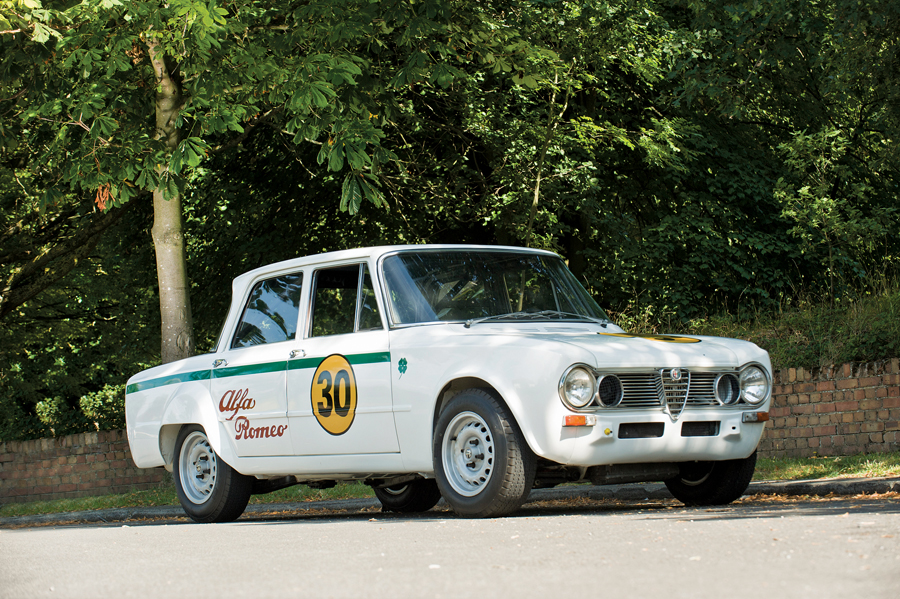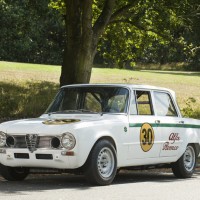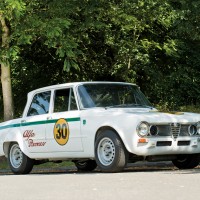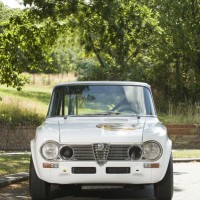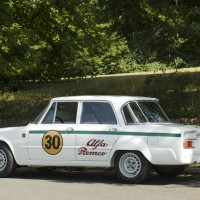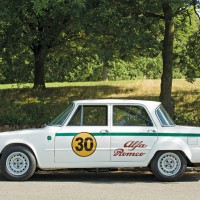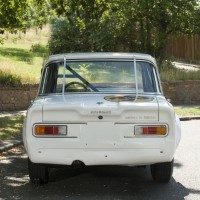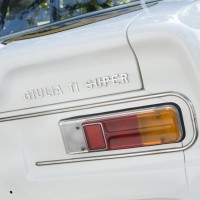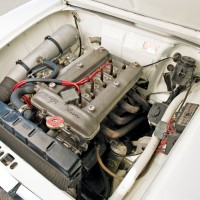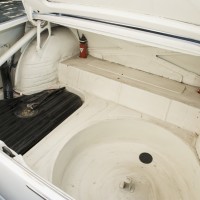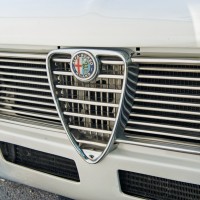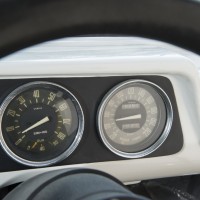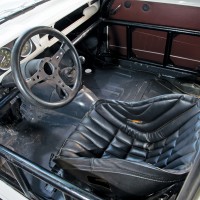SCM Analysis
Detailing
| Vehicle: | 1964 Alfa Romeo Giulia TI Super Competition Saloon |
| Years Produced: | 1963–64 |
| Number Produced: | 501 |
| Original List Price: | $4,300 |
| SCM Valuation: | Median to date, $60,000; high sale, $120,000 |
| Chassis Number Location: | On firewall above right cam |
| Engine Number Location: | On block below front carburetor |
| Club Info: | Alfa Romeo Owners Club |
| Website: | http://www.aroc-usa.org |
| Alternatives: | 1962–66 Lotus Cortina, 1962–64 Jaguar XKE 3.8, 1967–71 BMW 1600/2002 |
| Investment Grade: | B |
This car, Lot 367, sold for $60,884, including buyer’s premium, at Bonhams’ auction in Hendon, U.K., on December 10, 2015.
The intersection of “vintage racing cars” and “collectible cars” can be a very confusing place, particularly as regards Alfa Romeos in the past few years. Through the 1950s and 1960s, Alfa built tens of thousands of high-quality sporting cars that lent themselves easily to being raced, and a very large number of them got used for that purpose. Even today I can think of no car that is better both for a novice to safely learn the basics of racing and for a true master to demonstrate his skills: They are relatively affordable, dependable, fast enough, and extremely forgiving to drive at the limit. Alfas have been a ubiquitous component of sports, GT and sedan racing since things took off after the war, with the result that the most valuable production Alfas have been the racing ones, valued because of their “weapons-grade” utility as tools to go racing. The ordinary “street” versions were considered too pedestrian to be valuable.
In the past few years, however, this has been changing. In a world of $150,000 Porsche 356s and $75,000 Austin-Healeys, people are starting to remember that Alfas are Italian, moderately exotic, very pretty and great to drive. The collector value of even common Alfas has grown substantially, and the demand for the rare and desirable examples as street cars has really jumped. My shop is in the process of returning a racing Giulietta Spyder Veloce to a street version and roughly tripling the value for its owner. Important Alfas are now worth far more as collector cars than as racers, and the change has created some important value dislocations, as evidenced by today’s subject car.
From the roads to the tracks
The original Giulia sedan was introduced in 1962 as Alfa’s entry into the burgeoning “European sedan” market niche, to compete with Peugeot’s 404, the new Fiat 1500, and BMW’s anticipated 1600 (which became the 2002). The idea was for a practical, slightly upmarket 4/5-passenger sedan with enough sporting character to distinguish it. It used the 1,600-cc variant of Alfa’s Giulietta engine and a 5-speed transmission (with the shift on the column) along with a rather sophisticated live axle rear suspension and amazingly good aerodynamics for a sedan.
It was an excellent car and was soon recruited into competition use, both by customers and the factory. As a racing car, though, it had to match very precise specifications from its production origins in order to qualify for the appropriate FIA racing group (this is called “homologation”).
The basic Giulia TI was too heavy, too high off the ground, too clumsy in the interior, and not powerful enough to be competitive, so the factory set about creating the Giulia TI Super as a “homologation special” that would allow the required changes to be legal.
The TI Super used lightweight body panels, trim and interior to knock off 200 pounds (which doesn’t seem much until you consider having a passenger that heavy always riding with you), put big carburetors and bumpy cams into the engine for horsepower, dropped the suspension down over wider light-alloy wheels, and put cold-air ducting where the inner headlights used to be. The shift lever got moved to the floor.
Minimum production to qualify for the FIA group was 500 cars, so they built 501 of them, about half the production of the uber-collectible Alfa GTA.
In the grand tradition of homologation specials (virtually all the sporting manufacturers did this), the car was sold as a street vehicle without ever really being intended to be one: It was more expensive, less comfortable, and more demanding than its sister and thus only attractive to potential racers and the occasional die-hard enthusiast.
It was also less durable. The lightweight panels and trim were notoriously fragile and even more rust-prone than the normal “great Italian rust experiment” cars of the era.
Suddenly uber collectible
Between fragility, heavy use and an ordinary sedan appearance, very few Giulia TI Supers survived to the present, and they are arguably the most rare of the production Alfas. True Alfisti have always appreciated them, but their provenance — combined with their rarity — has recently turned them into seriously collectible cars. Really good ones have traded for well over $150,000.
So what is the deal on this one? This is what I have been able to determine:
A good friend of mine tried to buy it from the Japanese owner in December of 2014. The ask was a pretty firm $190,000, and the owner made comments about Bonhams wanting it. Although my friend was willing to pay well over $125,000, negotiations never really got started, and no deal was made.
The car was in Japan, which made it difficult to inspect. This, as well as language barriers, added to the problems.
The car was shipped to England and was consigned to the Bonhams Goodwood auction in September 2015 with an estimate of $100,000–$130,000. It did not sell.
The car was then entered in Bonhams’ RAF Hendon sale with a reduced reserve, and it sold for $60,884. My friend doesn’t follow auctions, and he had lost track of it. He told me that he regrets having missed the car. He doesn’t think the market has changed much in the past year, so he would have expected it to sell for much more.
From this information, it seems that we can build a pretty good cautionary tale about how and where to sell semi-collectible racing cars.
Regular readers know that I frequently opine that weapons-grade racing cars almost never sell well at auction, while more highly collectible cars tend to do very well.
The reasons behind this are a subject for another time, but I have consistently observed it for years now. Our subject Alfa Giulia TI Super occupies a difficult middle ground between the two categories.
The right people weren’t in the room
The cadre of serious Alfa collectors who will part with top money for a car like this is real but very small, insular, and not inclined to follow auctions, so they likely didn’t even know about it (my friend didn’t). Bonhams Goodwood (and Hendon) are arguably the best venues to auction racing cars, but the bidders there are racers looking for cars to play with. They are definitely not niche collectors.
At $61,000, this Alfa sold at probably a market-correct price for a good racing TI saloon. The fact that it was a rare and important Alfa racer got lost in the process.
The takeaway from this tale is simple but important: Auctions are a great place to sell cars, but not all cars. Niche market collectibles, particularly ones that can be perceived as either old racers to the general public or desirable possessions to the niche, run a serious risk of getting sold to the wrong group for the wrong price. I’m afraid that is what happened here.
I will suggest that the car was fairly bought as a racer but very, very well bought for what it really was and could be. ♦
(Introductory description courtesy of Bonhams.)
